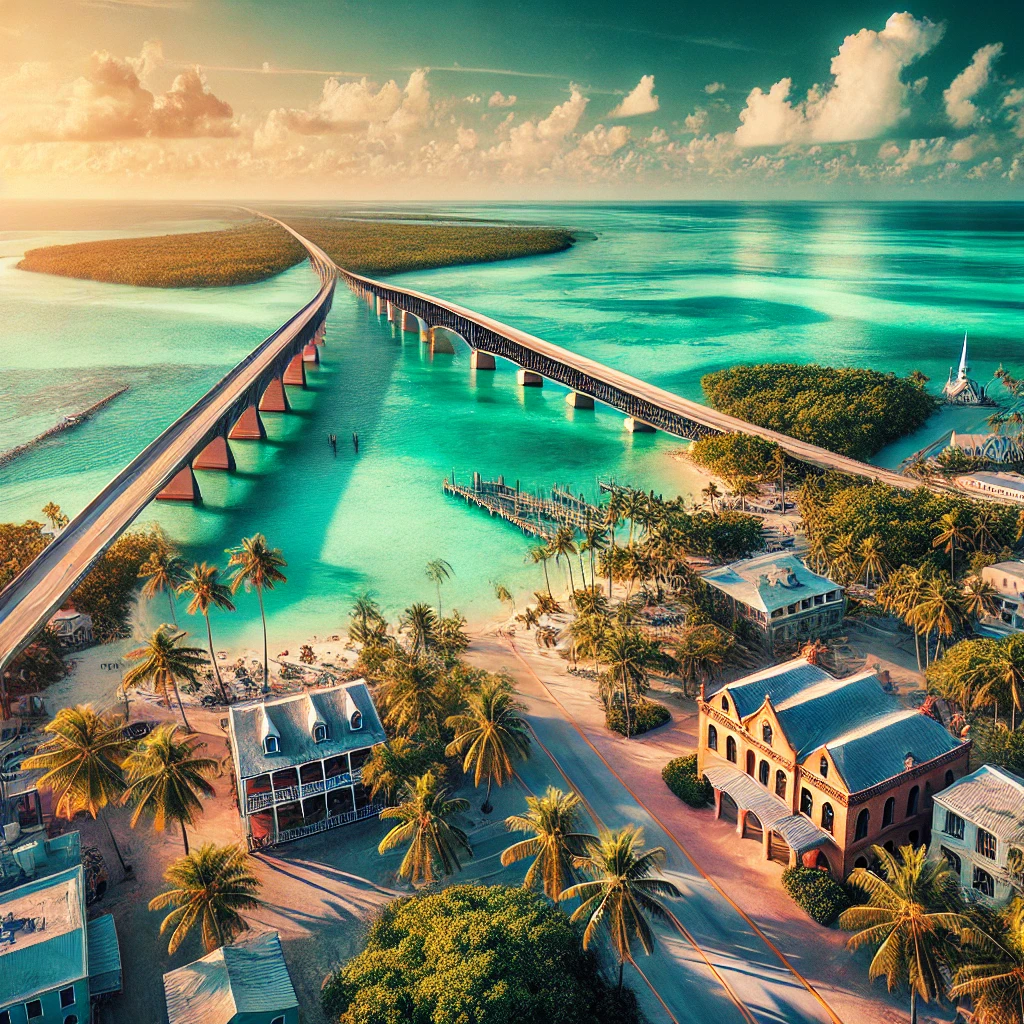Physical Address
304 North Cardinal St.
Dorchester Center, MA 02124
Physical Address
304 North Cardinal St.
Dorchester Center, MA 02124

Discover the full history of the Florida Keys, from ancient Native American tribes like the Calusa and Tequesta to Spanish exploration, piracy, the wrecking industry, Henry Flagler’s Over-Sea Railroad, and the rise of the Keys as a top tourist destination. Learn about the Overseas Highway, Key West’s naval history, the 1935 Labor Day Hurricane, and modern conservation efforts that balance tourism with protecting the unique coral reef ecosystem.
The Florida Keys, an enchanting coral cay archipelago stretching from the southeastern coast of Florida to Key West, have evolved from ancient Native American settlements to a modern tourist paradise. This detailed history explores their transformation, highlighting key periods and events that shaped their identity.
The earliest inhabitants of the Florida Keys were the Calusa and Tequesta tribes, who thrived in the region for thousands of years. Archaeological evidence, including shell middens and tools, suggests their economy was deeply rooted in fishing, hunting, and gathering. The Calusa, known as the “Shell Indians,” built complex societies, using shells for tools, weapons, and ceremonial purposes. The Tequesta occupied the Upper Keys and parts of the Miami region, similarly relying on seafood and trade with inland tribes.
In 1513, Juan Ponce de León became the first European to explore the Florida Keys, naming them Los Martires (The Martyrs) due to their rocky, barren appearance. Spanish attempts at colonization were largely unsuccessful due to fierce resistance from the native tribes and the harsh conditions of the region. The indigenous population suffered significant losses due to diseases introduced by European contact, leading to their decline by the early 1700s.
During Spanish rule, the Florida Keys remained a relatively uninhabited maritime passageway. The treacherous reefs surrounding the islands became notorious for shipwrecks, and Spanish galleons often fell victim to these waters while transporting goods between the New World and Spain.
In 1763, Spain ceded Florida to Great Britain, only to regain control in 1783. By 1821, Florida became a United States territory, and the U.S. government quickly realized the strategic value of the Keys. Key West, in particular, was established as an official U.S. port in 1822, marking the beginning of American settlement in the region.
During the early 19th century, the Florida Keys became a notorious haven for pirates and wreckers. Pirates such as Black Caesar operated in the area, using the labyrinthine waters to evade capture. The U.S. Navy established a presence in Key West in 1823 to combat piracy, securing vital shipping lanes.
Simultaneously, the wrecking industry flourished. The Florida Straits were among the most dangerous maritime passages, leading to frequent shipwrecks. Salvaging goods from these wrecks became a lucrative business, making Key West the richest city per capita in the United States by the mid-1800s.
During the Civil War (1861-1865), Key West remained under Union control, serving as a key naval base for blockading Confederate supply routes. Fort Jefferson, located in the Dry Tortugas, became a military prison and a strategic stronghold.
Post-war, the military presence in the Florida Keys continued to grow. The region played roles in the Spanish-American War (1898) and later became a hub for naval activity during both World Wars.
Key West’s economy thrived in the late 19th century due to the cigar industry, driven by Cuban immigrants who established factories in the city. At its peak, Key West was Florida’s largest city, with over 18,000 residents.
Meanwhile, Henry Flagler, a railroad magnate, envisioned an ambitious project: the Over-Sea Railroad, connecting mainland Florida to Key West. Construction began in 1905 and was completed in 1912, revolutionizing transportation and tourism in the Florida Keys.
On September 2, 1935, a Category 5 hurricane devastated the Florida Keys, wiping out much of Flagler’s railroad and causing massive casualties. The railroad was deemed irreparable, and in response, the U.S. government funded the construction of the Overseas Highway (1938), repurposing the remaining railway bridges to create a road connecting the Keys to the mainland. This solidified tourism as the region’s primary industry.
After World War II, the Florida Keys gained fame as a tourist destination, attracting visitors with its tropical climate, coral reefs, and fishing opportunities. Celebrities, writers, and artists, including Ernest Hemingway, popularized Key West as a cultural hotspot.
The 1960s and 1970s saw increased interest in scuba diving, sport fishing, and eco-tourism, with the coral reefs drawing divers worldwide. The construction of modern resorts and hotels solidified the region’s reputation as a top vacation spot.
By the 1990s, conservation efforts became a priority due to rising concerns over the environmental impact of tourism. The Florida Keys National Marine Sanctuary was established in 1990, protecting over 2,900 square nautical miles of ocean surrounding the Keys.
Today, the Florida Keys remain a premier vacation destination, known for attractions like Key West’s historic district, the Seven Mile Bridge, and John Pennekamp Coral Reef State Park. The region continues to balance tourism and conservation, preserving its unique ecosystem while catering to millions of visitors annually.
The Florida Keys’ history is a tale of resilience, exploration, and transformation. From their indigenous roots to European conquests, economic booms, and modern tourism, the Keys have been shaped by a dynamic interplay of nature, culture, and human ingenuity. Today, they stand as a testament to both historical significance and natural beauty, attracting travelers from around the world to experience their unique charm.